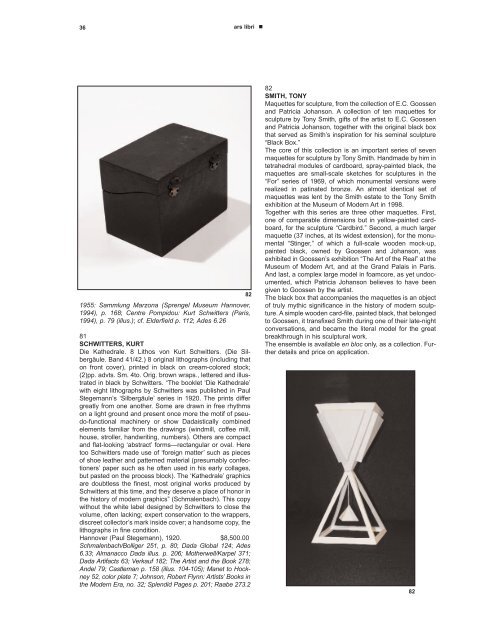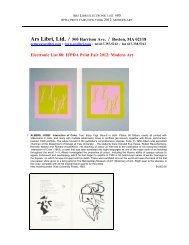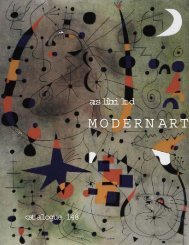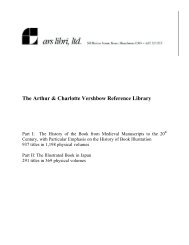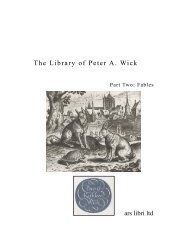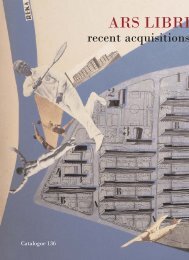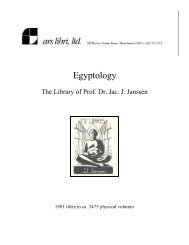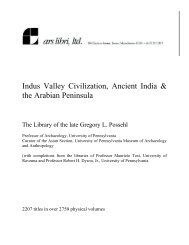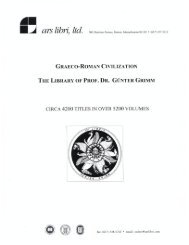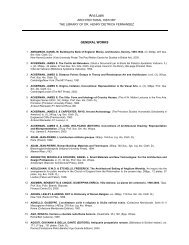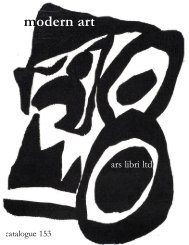You also want an ePaper? Increase the reach of your titles
YUMPU automatically turns print PDFs into web optimized ePapers that Google loves.
36<br />
ars libri �<br />
1955: Sammlung Marzona (Sprengel Museum Hannover,<br />
1994), p. 168; Centre Pompidou: Kurt Schwitters (Paris,<br />
1994), p. 79 (illus.); cf. Elderfield p. 112; Ades 6.26<br />
81<br />
SCHWITTERS, KURT<br />
Die Kathedrale. 8 Lithos von Kurt Schwitters. (Die Silbergäule.<br />
Band 41/42.) 8 original lithographs (including that<br />
on front cover), printed in black on cream-colored stock;<br />
(2)pp. advts. Sm. 4to. Orig. brown wraps., lettered and illustrated<br />
in black by Schwitters. “The booklet ‘Die Kathedrale’<br />
with eight lithographs by Schwitters was published in Paul<br />
Stegemann’s ‘Silbergäule’ series in 1920. The prints differ<br />
greatly from one another. Some are drawn in free rhythms<br />
on a light ground and present once more the motif of pseudo-functional<br />
machinery or show Dadaistically combined<br />
elements familiar from the drawings (windmill, coffee mill,<br />
house, stroller, handwriting, numbers). Others are compact<br />
and flat-looking ‘abstract’ forms—rectangular or oval. Here<br />
too Schwitters made use of ‘foreign matter’ such as pieces<br />
of shoe leather and patterned material (presumably confectioners’<br />
paper such as he often used in his early collages,<br />
but pasted on the process block). The ‘Kathedrale’ graphics<br />
are doubtless the finest, most original works produced by<br />
Schwitters at this time, and they deserve a place of honor in<br />
the history of modern graphics” (Schmalenbach). This copy<br />
without the white label designed by Schwitters to close the<br />
volume, often lacking; expert conservation to the wrappers,<br />
discreet collector’s mark inside cover; a handsome copy, the<br />
lithographs in fine condition.<br />
Hannover (Paul Stegemann), 1920. $8,500.00<br />
Schmalenbach/Bolliger 251, p. 80; Dada Global 124; Ades<br />
6.33; Almanacco Dada illus. p. 206; Motherwell/Karpel 371;<br />
Dada Artifacts 63; Verkauf 182; The Artist and the Book 278;<br />
Andel 79; Castleman p. 158 (illus. 104-105); Manet to Hockney<br />
52, color plate 7; Johnson, Robert Flynn: Artists’ Books in<br />
the Modern Era, no. 32; Splendid Pages p. 201; Raabe 273.2<br />
82<br />
82<br />
SMITH, TONY<br />
Maquettes for sculpture, from the collection of E.C. Goossen<br />
and Patricia Johanson. A collection of ten maquettes for<br />
sculpture by Tony Smith, gifts of the artist to E.C. Goossen<br />
and Patricia Johanson, together with the original black box<br />
that served as Smith’s inspiration for his seminal sculpture<br />
“Black Box.”<br />
The core of this collection is an important series of seven<br />
maquettes for sculpture by Tony Smith. Handmade by him in<br />
tetrahedral modules of cardboard, spray-painted black, the<br />
maquettes are small-scale sketches for sculptures in the<br />
“For” series of 1969, of which monumental versions were<br />
realized in patinated bronze. An almost identical set of<br />
maquettes was lent by the Smith estate to the Tony Smith<br />
exhibition at the Museum of Modern Art in 1998.<br />
Together with this series are three other maquettes. First,<br />
one of comparable dimensions but in yellow-painted cardboard,<br />
for the sculpture “Cardbird.” Second, a much larger<br />
maquette (37 inches, at its widest extension), for the monumental<br />
“Stinger,” of which a full-scale wooden mock-up,<br />
painted black, owned by Goossen and Johanson, was<br />
exhibited in Goossen’s exhibition “The Art of the Real” at the<br />
Museum of Modern Art, and at the Grand Palais in Paris.<br />
And last, a complex large model in foamcore, as yet undocumented,<br />
which Patricia Johanson believes to have been<br />
given to Goossen by the artist.<br />
The black box that accompanies the maquettes is an object<br />
of truly mythic significance in the history of modern sculpture.<br />
A simple wooden card-file, painted black, that belonged<br />
to Goossen, it transfixed Smith during one of their late-night<br />
conversations, and became the literal model for the great<br />
breakthrough in his sculptural work.<br />
The ensemble is available en bloc only, as a collection. Further<br />
details and price on application.<br />
82


